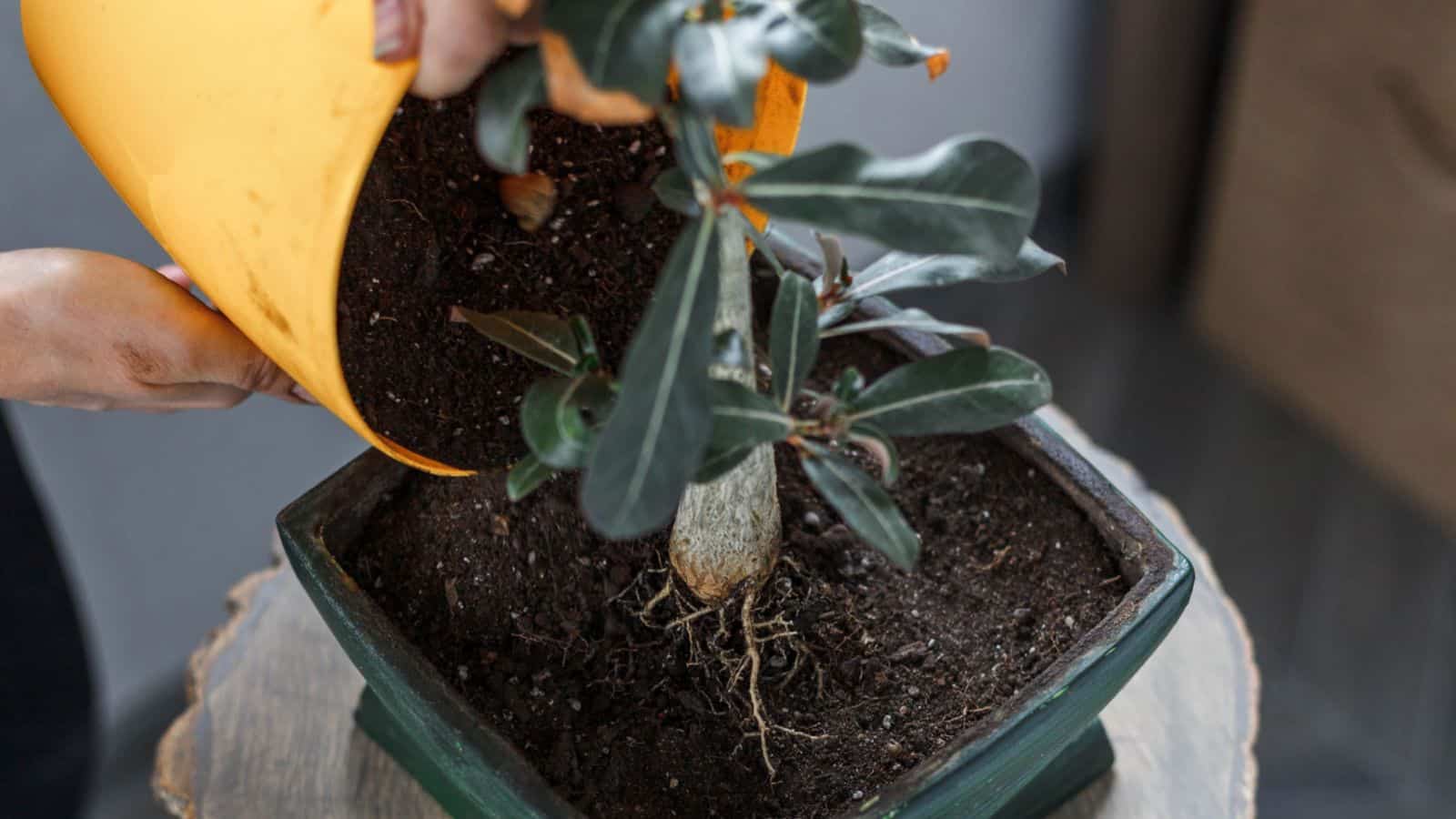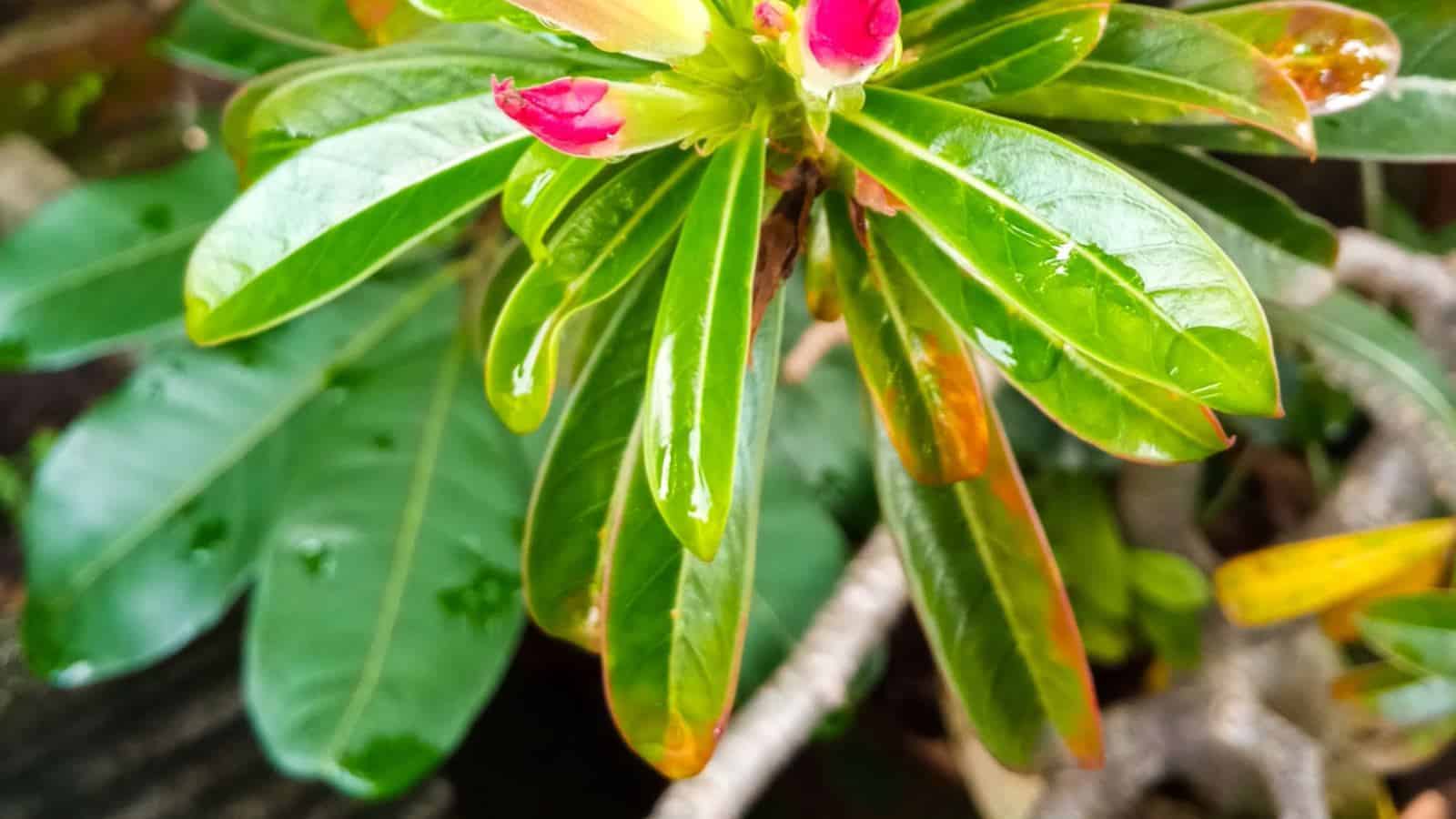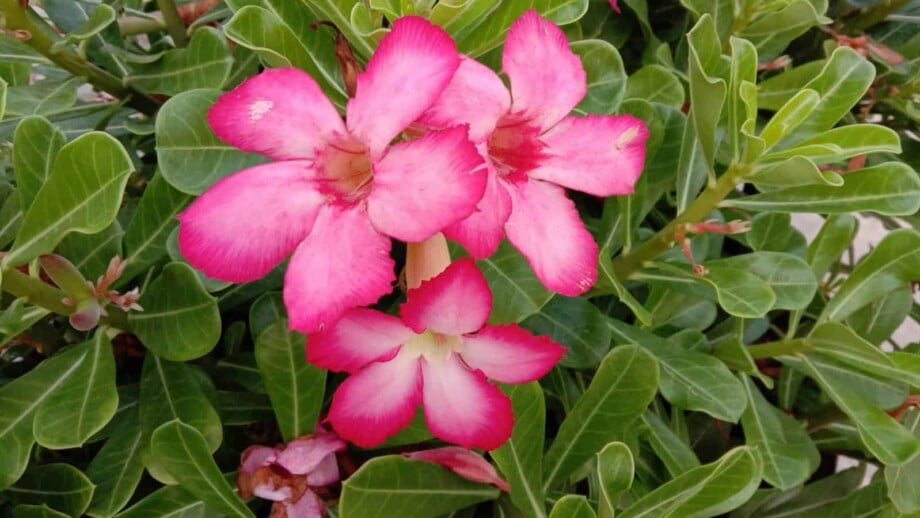Desert Rose plant, scientifically known as Adenium obesum, is a fascinating species that adds an exotic touch to any garden. Renowned for its hardy nature and stunning, trumpet-shaped flowers, it is a member of the succulent family.
In Africa and the Arabian Peninsula, its land of origin, it’s common to find this plant thriving in arid conditions; hence the common name “desert rose.”
Adenium obesum boasts beautiful blooms that typically showcase bright pink to red hues and commonly appear during the summer months. These radiant flowers are the plant’s trumpets, greeting you with an unrivaled spectacle.
Complementing these vibrant blossoms is a rich foliage of dark green leaves which, surprisingly for a plant that thrives in arid climates, are not adapted to retain a substantial amount of moisture.
Equally as captivating as its breathtaking blooms is the Desert Rose’s unique caudex, or trunk. This swollen stem serves as a reservoir storing water, which allows the desert rose to withstand drought.
It is this feature that, along with its growth habit, can enable the adenium to be cultivated as a bonsai plant.
As a houseplant, the desert rose’s drought-loving nature makes it perfect for decks and patios, and its year-round green leaves are especially appreciated during winter months.
As a master gardener, I can say for sure that this succulent plant truly embodies the resilience and beauty of nature’s creations, making it a wonderful addition to any collection of cacti and succulents.
I’ll go over everything you need to know to plant, grow, and care for desert rose plant easily at home.

Botanical Name: Adenium obesum
Common Name: Desert Rose, Sabi Star, Impala Lily
Family: Apocynaceae
Plant Type: Succulent
Hardiness Zones: 11 – 12 (USDA)
Sun Exposure: Full sun
Soil Type: Well-draining soil
Soil pH: Neutral to slightly acidic
Bloom Time: Summer
Flower Color: Varied, most commonly red and pink
Native Area: Africa, semi-arid regions of Arabian Peninsula
Desert Rose Plant Care
The Desert Rose, or Adenium obesum, is a stunning succulent plant native to Africa and the Arabian Peninsula, widely admired for its beautiful trumpet-shaped flowers and unique caudex – a swollen trunk.
A great choice for patios and decks during the warm summer months, this resilient plant thrives in full sun and high heat typical of its natural, arid climate. Desert Rose performs well in sandy potting mixes with plenty of drainage holes to avoid overwatering and root rot.

During the growing season, feed it with a diluted liquid fertilizer to encourage new growth and vibrant blooms. In colder climates or during winter months, bring this plant indoors to protect it from frost and freezes; its hardy nature also makes it a great houseplant.
Prune your desert rose in early spring to maintain its bonsai plant-like appearance and keep an eye out for pests like mealybugs, aphids, and spider mites that might cause an infestation.
Regularly checking the leaves and stems helps to keep this succulent in top condition.
Light
Adenium obesum, commonly known as the desert rose plant, naturally thrives in full sun. These succulents revere direct sunlight, perfect for bright patios or decks.
Being able to withstand drought conditions associated with arid places, they will flourish in sun-soaked locations where other plants wither.
Housing them indoors as a houseplant, they’ll require a minimum of six hours of direct sunlight per day especially during their growing season, which encompasses the summer months.

It’s important to remember while they adore bright light, in USDA zones where intense summer sun is common, a bit of afternoon shade can protect the plant from scorching.
Water
An inherent characteristic of desert roses is their ability to resist drought thanks to their caudex or enlarged trunk that reserves water for long periods. However, in spite of this, they require consistent watering in their growing season, most commonly the summer months.
A good rule of thumb is to maintain a cycle of letting the plant dry out before the next watering, as excess moisture could lead to root rot. If you pot your desert rose, ensure the pot has ample drainage holes.

Overwintering decrease watering to almost nothing as desert rose plants undergo a period of dormancy during the winter months. During this dormant period, protect them from frosts or freezes as these might harm the plant.
Watering desert rose requires a careful balance to mimic its native African and Arabian Peninsula climate. In the summer months, when the sun is at its full intensity, this succulent plant needs regular watering.
Unlike common houseplants, overwatering can lead to root rot due to excessive moisture. Hence, a sandy potting mix and pots with sufficient drainage holes are paramount.

During the winter months, when the plant enters a dormant phase, watering should be reduced significantly, allowing the soil to dry between waterings.
The desert rose can tolerate drought but won’t cope well with frost or humidity, making water regulation crucial in different climates and USDA zones.
Soil
Desert Rose plant has unique soil requirements that mimic its native drought conditions found in Africa and the Arabian Peninsula. Like cacti and other succulent plants, it thrives best in a well-draining potting mix that replicates the arid sand of its natural habitat.
The presence of drainage holes in the pot is crucial to prevent water accumulation, as it steers clear of root rot.
Overwatering, especially during the cooler winter months, can be a fatal mistake for this sturdy plant.
A combination of regular potting soil with perlite, coarse sand or gravel aids in retaining necessary moisture while still providing excellent drainage.

Raised garden beds, patios, or decks make ideal locations for your desert rose if you’re unable to find pots with sufficient drainage.
Temperature and Humidity
Desert rose is a drought-resistant plant, truly savoring the heat of summer months while also being able to withstand colder winter months as a houseplant if cared for properly.
Humidity should be moderate to low for this plant, as too much moisture can lead to problems such as root rot caused by poor draining potting mix or overwatering.
You may conveniently place it on patios or decks, but avoid leaving it in direct sunlight for too long.
Pruning
Desert rose can make a striking bonsai plant due to its thick, enlarged caudex (trunk). Pruning these succulent plants is vital to stimulate new growth, and encourage fuller foliage and spectacular blooms.
Pruning, usually performed during the growing season of summer months, typically targets long stems, ensuring the plant maintains its splendid bushy aspect.
Remember to let the cut end dry before placing the plant back in its environment to prevent sap from oozing out.
This process also safeguards the plant against potential infestations from pests such as mealybugs, spider mites, and aphids, which are attracted by the sap.

During the winter months, it is important to protect the plant from frost and freezes, as they can cause significant damage. Ideally, the plant should experience a climate no colder than 50 degrees Fahrenheit.
If you’re growing desert rose in a pot, it’s advisable to bring it inside during cold spells, specifically if you’re residing in a region where the winters are harsh.
To prepare for overwintering, prune back new growth from the summer months, which will slow the plant down for its dormant season.
Check regularly for pests such as spider mites, mealybugs, and aphids that take advantage of indoor conditions and could pose a threat to your succulent.
Types of Desert Rose
There are numerous Adenium species. Adenium obesum, on the other hand, is the most common and easiest to find. Some other subspecies include:
Adenium obesum subsp. oleifolium: This species, native to South Africa and Botswana, can reach 16 inches in height and has a large tuberous stem, narrow olive green blade-like leaves, and salmon, pink, or pale pink tubular flowers.

Adenium obesum subsp. socotranum: This is the largest of the species, native to Socotra, an Indian Ocean island between Somalia and Yemen. It can grow to be 15 feet tall with an 8-foot diameter trunk. In spring, when the plant has no leaves, pink flowers up to 5 inches in diameter bloom.

Adenium obesum subsp. somalense: This species, which is native to Eastern Africa, has twisting branches and narrow blade-like leaves. It matures at 16 feet tall with a swollen and often twisted trunk. Flowers with a trumpet shape can be pink, white, or crimson red.

Adenium obesum subsp. swazicum: Native to Swaziland and South Africa, this dwarf species rarely grows taller than 2 feet. It features showy flowers that range in color from pink to a deep reddish-pink. Summer impala lily is another name for this variety.

How to Plant Desert Rose From Seed
Step 1: Selecting Your Pot
Choose a shallow pot with drainage holes. Its caudex, or trunk, stores moisture and as such, can easily succumb to root rot if overwatered.
And so a pot with proper drainage is absolutely vital. Try using a mixture of potting mix and sand to replicate the desert rose’s natural, dry environment.
Step 2: Preparing Your Seeds
Desert rose seeds should be soaked in warm water for 1-2 hours to soften them.
Much like a cactus, this succulent has adapted to the harsh, drought conditions of its native environment, so this step helps jumpstart the germination process.
Step 3: Planting Your Seeds

Sprinkle your seeds on the surface of your potting mix and lightly cover with sand.
Position your pot in an area with full sun exposure, but try to protect the seedlings from direct sunlight to prevent burns.
Step 4: Proper Care and Attention
Maintain a moisture level that avoids both drying out and overwatering. Watering in the morning during the growing season (summer months) and sparingly during winter, allows the plants to dry before the cooler night temperatures, and lessens the risk for root rot.
Regularly check for pests such as mealybugs, spider mites, and aphids which can lead to infestation if left untreated.
Step 5: Watching for Growth
Once your desert rose has sprouted, be on the lookout for new growth. The distinct leaves of your succulent will be accompanied by its characteristic trumpet-shaped flowers, or blooms, often compared to trumpets, in hues of pink and red.

How to Propagate Desert Rose
Preparing for Propagation
The best time to propagate this plant is during the growing season, primarily in the summer months. During this time, the plant will go into a dormant state, where it will produce new growth.
Ensure the plant is healthy and free from pests and diseases like mealybugs, spider mites, and aphids, as infestations can hinder the progress of new growth.
Cutting and Rooting
Using a sterilized blade or shears, cut a healthy branch from the desert rose plant. Make sure to make your cut on a stem with at least two leaves.
Always be cautious while doing this as the plant’s sap could be irritating to the skin. Leave the cut end to dry for about a week, allowing it to form a callus. This prevents root rot when planted.
Planting
Prepare a pot with excellent drainage holes and fill it with a well-draining potting mix, a combination of standard potting soil and coarse sand works well.
This step is crucial as succulent plants, much like cacti, do not enjoy being overwatered and require soil that can quickly drain excess moisture.

After a week has passed from the cutting process, plant the cut end into the prepared pot.
Caring for the Plant Post Propagation
For the first few weeks, keep the soil slightly moist but never soggy to prevent root rot. The newly potted desert rose loves full sun but protect it from direct sunlight, a semi-shaded area on patios or decks will be ideal. Gradually expose the plant to direct sunlight as it matures.
Desert rose is a star among succulents, and with these steps, you’ll be able to propagate and care for this beauty, bringing an essence of the African deserts to your home and garden.
How to Pot or Repot Desert Rose
Step 1: Select the Right Pot
Choosing the correct pot is vital for the growth of your desert rose plant. This succulent plant hails from Africa and the Arabian Peninsula, adapting to survive periods of drought.
And so, it prefers a shallow, wide pot with ample drainage holes to avoid pooling water and subsequent root rot. The pot should mimic the natural growing conditions of a succulent, allowing excess moisture to escape quickly.
Step 2: Prepare the Potting Mix
Desert rose isn’t quite as resilient as a cactus but does belong to the family of succulent plants. As such, it appreciates a well-draining, sandy potting mix, similar to its original habitat.
To make your own mix, combine equal parts of coarse sand, potting soil, and perlite; the latter aids in aeration, preventing the pivotal caudex (or trunk) from rotting.
Never overwater the plant, as abundant humidity can lead to fungal infestation.

When potting your Adenium obesum, ensure the bulbous caudex is partially above the soil; this will stimulate new growth and keep the plant healthy.
The plant’s structure consists of a large swollen trunk (caudex) supporting long slender stems and leaves, trumpeting beautiful blooms it can impressively sustain even in full sun due to its robust nature.
If repotting a desert rose, carefully remove it from its current pot, shake off the old soil, and trim any rotten roots off before repotting to promote healthy growth.
Step 4: Caring Post Potting
After repotting the desert rose, it is important to maintain the correct climate for the plant to flourish. This plant likes warmth and full sunlight.
Still, during the summer months, it should be shielded from direct sunlight in the afternoon when the sunlight is most intense.
During the winter months, this bonsai plant, as it is also called due to its appearance, should be kept indoors or in sheltered outdoor areas like patios and decks, away from frost and freezes.
Common Pests and Plant Diseases for Desert Rose
Desert rose is a remarkable succulent plant. However, despite its hardy nature, it isn’t immune to pests and diseases.
Spider Mites

One of the formidable foes of the beautiful oblong leaves of the Desert Rose are spider mites. These tiny pests pierce the foliage and sap out the vital nutrients leading to the yellowing and eventual fall of the leaves.
A severe infestation can hinder new growth and reduce the vibrancy and number of beautiful, trumpet-shaped flowers.
Mealybugs

Another pest to keep an eye out for are the mealybugs. These sap-sucking pests leave your Adenium Obesum looking lackluster as they feed off the stems and underneath the leaves.
A heavy mealybug invasion often leads to a sooty mold infestation, a condition that shrouds the plant and blocks it from enjoying direct sunlight, essential for its growth and development.
Aphids

Aphids are tiny pests that cluster on new growth and buds, causing them to become deformed.
They are especially deleterious during the growing season and summer months. The sap they extract can also lead to the development of sooty mold.
Root rot

One of the diseases that commonly plague a desert rose plant is root rot, often caused by providing the plant with more moisture than it requires.
Overwatering, coupled with a pot with poor drainage holes and a sand-heavy potting mix, creates a soggy environment conducive for root rot.
Fungus

Humidity and the persistently moist conditions are perfect breeding grounds for fungi. The fungus appears as black spots on the leaves and quickly spreads across the plant, compromising its health.
Common Plant Problems and Solutions for Desert Rose
Brown Tips

Brown tips on leaves can occur due to insufficient humidity or overexposure to direct sunlight.
You may safeguard your succulent by positioning it under light shade during midday in the summer months or placing it in a pot with a saucer filled with pebbles and water to enhance humidity.
Yellowing Leaves

Heavy watering often causes yellowing leaves, as the desert rose tends to prefer conditions resembling its native arid climates.
To mitigate this effect, ensure your pot has ample drainage holes to avoid an excess buildup of moisture.
Overwatering may lead to root rot, a serious condition for succulents and cacti. Ideally, the desert rose should be watered enough to keep the soil slightly damp, not saturated.
Dropping Leaves
Sometimes the desert rose may drop its leaves during the winter months if it experiences frost or freeze. As the plant is native to warm climates, frost or cold freezes can hinder its growth.
A solution is to keep the desert rose as a houseplant during the winter or keep it on patios or decks, where it is easier to bring inside during cold snaps.
Poor Blooming

Desert rose blooms best when exposed to full sun conditions but needs a well-drained potting mix to prevent overwatering.
If the plant doesn’t produce vibrant blooms, consider adding a liquid fertilizer to the watering regimen during the growing season.
Sands can be mixed with regular potting soil to mimic the native sandy soils of Africa and the Arabian peninsula.
By following these tips, you can help your desert rose thrive in almost any condition. Happy gardening!
Other Plant Guides from Planet Natural:











